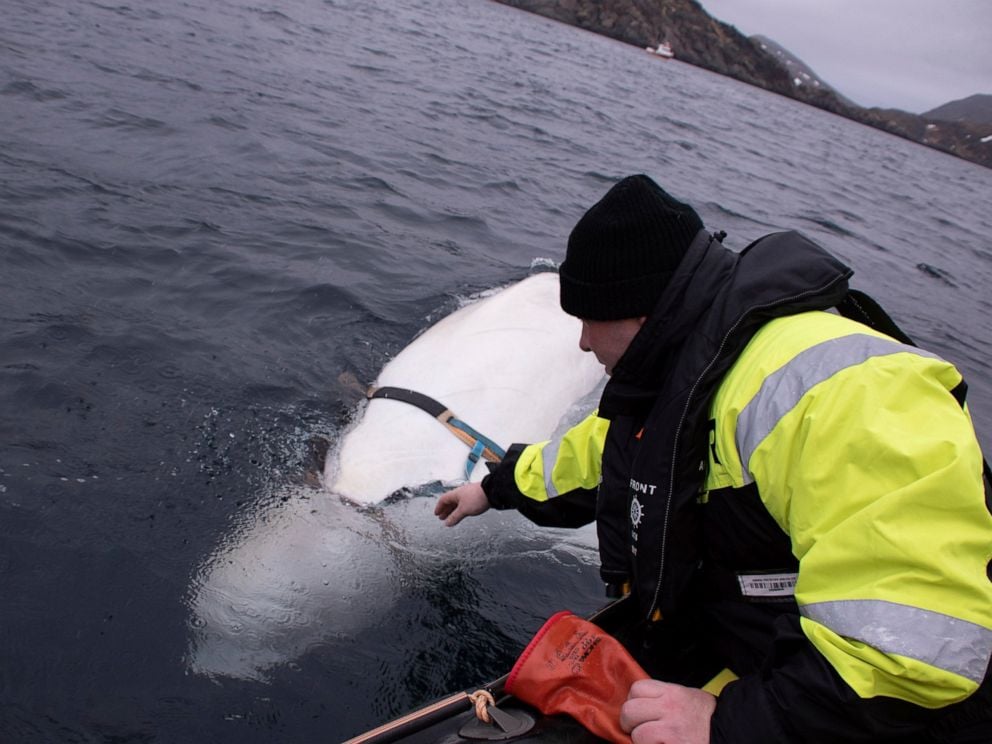
Mention the word spy, and the images that come to mind are those of secretive, stealthy fictional characters like British Secret Service agent James Bond and former CIA assassin Jason Bourne. However, the alleged Russian mole, who recently "defected" to Norway, fits none of those descriptions. In fact, it is not even a person, but a friendly Beluga whale who loves to interact with humans!
Norwegian fishermen first encountered the marine mammal on April 26, 2019, when it began hovering around their boats in the waters close to the small fishing village of Inga. “We were going to put out nets when we saw a whale swimming between the boats,” fisherman Joar Hesten told Norwegian broadcaster NRK. “It came over to us, and as it approached, we saw that it had some sort of harness on it.”
After several attempts to remove the whale's strap from aboard the boats failed, one of the fishermen leaped into the freezing arctic waters to rid the animal of the tight noose. A closer examination of the harness revealed the words "Equipment of St. Petersburg," and a mounting point for a camera. This, together with the beluga's unusually friendly behavior, as well as its location in the vicinity of the Kola Peninsula, which is home to several Russian military bases, has led some experts to proclaim the mammal a spy.

One of the proponents of the theory, Audun Rikardsen, a professor in freshwater and marine biology at the University of Tromsø, told NRK, “We know that in Russia they have had domestic whales in captivity and also that some of these have apparently been released. Then they often seek out boats.” To rule out the possibility the whale may have been used for scientific research, Rikardsen reached out to some Russian scientists. He says, "A Russian colleague said they don't do such experiments, but she knows the navy has caught belugas for some years and trained them - most likely it's related to that."
Rikardsen's theory gets further credence from a 2017 report by TV Zvezda, a station owned by Russia's defense ministry, which revealed that the army was training beluga whales, seals, and bottlenose dolphins for military purposes. According to The Guardian, the training, conducted by Murmansk Sea Biology Research Institute in northern Russia, was to see if the mammals could be taught to "guard entrances to naval bases in the arctic regions," and “assist deepwater divers and if necessary, kill any strangers who enter their territory." It purportedly also taught dolphins and seals to carry tools for divers and to detect torpedoes, mines, and other ammunition, which had sunk underwater.

Though the facts seem to all point in the direction of Rikardsen's hunch, Morten Vikeby, a former reporter with Norwegian publication Fiskeribladet, is not sure the beluga was a spy. She thinks it may have been a therapy whale. "I recognized him from a story we had made," she told the paper. "It was wearing a harness because it was used to dragging boats with children on board. This is the reason why he is so social."
Regardless of its past, the friendly whale, which can be seen frolicking around the frigid harbor of Tufjord, has become a local and international celebrity, with thousands of people visiting daily to catch a glimpse. The marine mammal, nicknamed "Hvladimar" by the Scandinavian media, is so comfortable around humans that it swims to the dock to get its nose petted and even retrieves plastic rings thrown into the sea. On May 6, 2019, the gentle giant also brought back an iPhone that slipped into the sea from the hands of an excited fan trying to capture the whale on tape!
Meanwhile, Norwegian officials are hoping an animal conservation organization will step in to help rehabilitate the mammal back to the wild. Rikardsen says, “This is a tame animal that is used to getting food served, so that is why it has made contacts with the fishermen. The question is now whether it can survive by finding food by itself. We have seen cases where other whales that have been in Russian captivity doing fine.” The expert, however, cautions that it will not be easy and says that until the beluga figures out how to hunt for food and finds a pod of whales to help it navigate through the open oceans, it will keep depending on humans. Hopefully, "Hvladimar" will find a group of belugas who will teach it how to function as a wild whale again.
Resources: Slate.com, the guardian.com, military.com,bbc.com,dw.com
